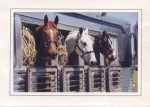 As a horse owner, it’s likely that it will be necessary to trailer your horse at one time or another. Whether it’s a short distance to nearby trails or several hours’ drive to a competition, with a bit of care and attention, you can safely get your horse to where you’re going and minimize the possibility of any mishaps or undue stress.
As a horse owner, it’s likely that it will be necessary to trailer your horse at one time or another. Whether it’s a short distance to nearby trails or several hours’ drive to a competition, with a bit of care and attention, you can safely get your horse to where you’re going and minimize the possibility of any mishaps or undue stress.
While it’s just common sense to ensure that your horse has been trained to load and unload safely and in a calm manner well in advance, proper planning ahead for any trip can ensure that the entire transportation process goes smoothly and is safe for both horse and handler.
“No matter the distance, trip planning is the key to successful journeys, including knowing the weather conditions, road construction, etc.,” says Penny Lawlis, Humane Standards Officer with the Animal Health and Welfare Branch of the Ontario Ministry of Agriculture and Food (OMAF) in Guelph, Ontario. Lawlis also currently sits on the National Farm Animal Care Council and teaches a graduate level course in practical animal welfare assessment for the University of Guelph.
When transporting a horse, it’s important to plan out the route ahead of time, avoiding peak times in busy areas to avoid sitting in traffic. One should also be aware of any possible inclement weather. If the weather could make driving difficult, reschedule the trip for another day.
Lawlis also stresses the importance of trailering only when the horse is healthy. “One of the issues we encounter frequently is animals [including horses] that are loaded and transported when they are not fit to be transported,” she says. “Unfit horses must not be loaded unless they are being shipped on the advice of a veterinarian to a vet hospital for treatment. Compromised horses should not be transported mixed in with fit horses in the same compartment.”
Learn to assess your horse for health and fitness before trailering. Check and record your horse’s vital signs, such as temperature, respiration and pulse, as well as how much it drinks ahead of time. This provides important personal information as to what is normal for your horse and will assist in spotting any problems on the day of travel and upon arrival. If in doubt, check with your veterinarian. The new 2013 Equine Code of Practice also has a reference on Appendix H – The Transport Decision Tree.
Trailer Basics
The type of trailer used, whether it’s a straight load, slant load or stock trailer, is primarily based on owner preference. While some horses will load more easily into a stock trailer because of its openness, make sure it offers sufficient head room for the height of your horse.
“When it comes to stock trailers, smaller horses such as Quarter Horses can safely fit, but it’s considered to be unsafe for taller breeds such as Thoroughbreds, Warmbloods, Drafts, etc., as there is insufficient head room,” says Lawlis. “Too small of a space will hinder your horse’s ability to move and balance itself and could increase the likelihood of your horse injuring itself during transit, as well as developing loading problems.”
Horses are subject to the same laws and regulations as other animals during transport. Lawlis emphasizes that horse owners and others should be familiar with the regulations and policies administered by the Canadian Food Inspection Agency. The regulations cover areas such as allowable time without feed, water and rest, and using equipment that won’t cause injury. The Regulations can be found at http://www.inspection.gc.ca/animals/terrestrial-animals/humane-transport/general-public/eng/1363740981698/1363741144174.
Handling Travel Emergencies
Even with the best intentions, sometimes mechanical breakdowns or even accidents can occur. Knowing how to handle an emergency situation when on the road can be the difference between being helpful and helpless.
Horse owners should inspect the trailer before every trip to make sure it is safe to operate and safely hitched to the truck. “Always check your trailer before starting out and recheck it after each stop, and always carry first aid kits for your horse, yourself, your vehicle and your trailer,” advises Michelle Staples, a Horse Safety Specialist located in the Niagara Region of Ontario. Author of Save Your Horse! A Horse Owner’s Guide to Large Animal Rescue, Staples also teaches CPR, CERT (disaster preparedness), Horse Awareness and Safety, Introduction to Large Animal Rescue for Horse Owners, and Emergency First Aid for Pets.
In an accident when emergency responders are called in for assistance, chances are their knowledge of horses will be limited, and they will be looking to the horse owner or handler for guidance. Staying calm and quiet allows you to think clearly in emergency situations.
“Safety is the number one issue in an accident,” says Staples. “If you are hysterical or interfere with a rescue in a way that makes the rescue more difficult or less safe, you will be set aside and disregarded.”
In the case of a trailer rollover, Staples advises to check out all people and pets travelling with you so you know what to report to the 9-1-1 dispatcher. “Take note of where you are and advise them that emergency assistance is required and you may possibly require transport for your horse, and that you need a large animal veterinarian dispatched immediately,” she says. “While waiting, your first inclination is to open up the trailer and go in to help your horse, but that’s an action that can get both you and your horse killed. An open door is an invitation for it to try and escape. Instead, find the smallest opening possible to peek in. Stay calm. Most horses survive rollovers if they’re in a well-maintained, sturdy trailer.”
However, every circumstance is different and should be viewed in a separate manner. Staples recalls a trailering incident with an unexpected flat tire on the Golden Gate Bridge in California several years ago when she was traveling with a friend. “She chose to pull off at the nearest flat spot and change the tire with the horse still inside,” she says. “However, I don’t think I’d do that now.”
Instead, she says she would have pulled over to a spot where she could safely offload the horse and call for roadside assistance such as USRider, a company that handles horses and trailers on a daily basis. Once assistance arrives, they would help her offload the horse and place it in some form of a contained area, such as pipe panels set up on the side of the trailer, or a roll of construction fencing with polls to keep it rigid or even something as simple as ropes strung around trees.
“The problem with leaving a horse in the trailer is that when you jack up the side to remove and replace the tire, the horse will scramble, upsetting the balance of the trailer which could create a negative outcome for horse and handler,” she adds.
When it comes to trailering, make every trip a positive experience by planning it out ahead of time to ensure that your horse arrives safe. Have a contingency plan available to address unexpected difficulties. Learning to be proactive rather than reactive goes a long way toward minimizing stressful situations for both you and our horse.
For more information regarding equine transport, visit The Code of Practice for the Transportation of Livestock – Horses found at www.nfacc.ca/codes-of-practice/equine, www.omafra.gov.on.ca/english/livestock/horses/facts/info_trailering.htm, and www.mto.gov.on.ca/english/safety/topics/trailer.shtml.
Michelle Staple’s Large Animal Rescue website can be viewed at www.saveyourhorse.com.
Sign up for our free e-newsletter at EquineGuelph.ca which will deliver monthly welfare tips throughout 2014 and announce tools to aid all horse owners in carrying out their ‘Full-Circle-Responsibility’ to our beloved horses.
Visit Equine Guelph’s Welfare Education page for more information http://www.equineguelph.ca/education/welfare.php
Equine Guelph is the horse owners’ and care givers’ Centre at the University of Guelph. It is a unique partnership dedicated to the health and well-being of horses, supported and overseen by equine industry groups. Equine Guelph is the epicentre for academia, industry and government – for the good of the equine industry as a whole. For further information, visit www.EquineGuelph.ca.
Story by: Barbara Sheridan



